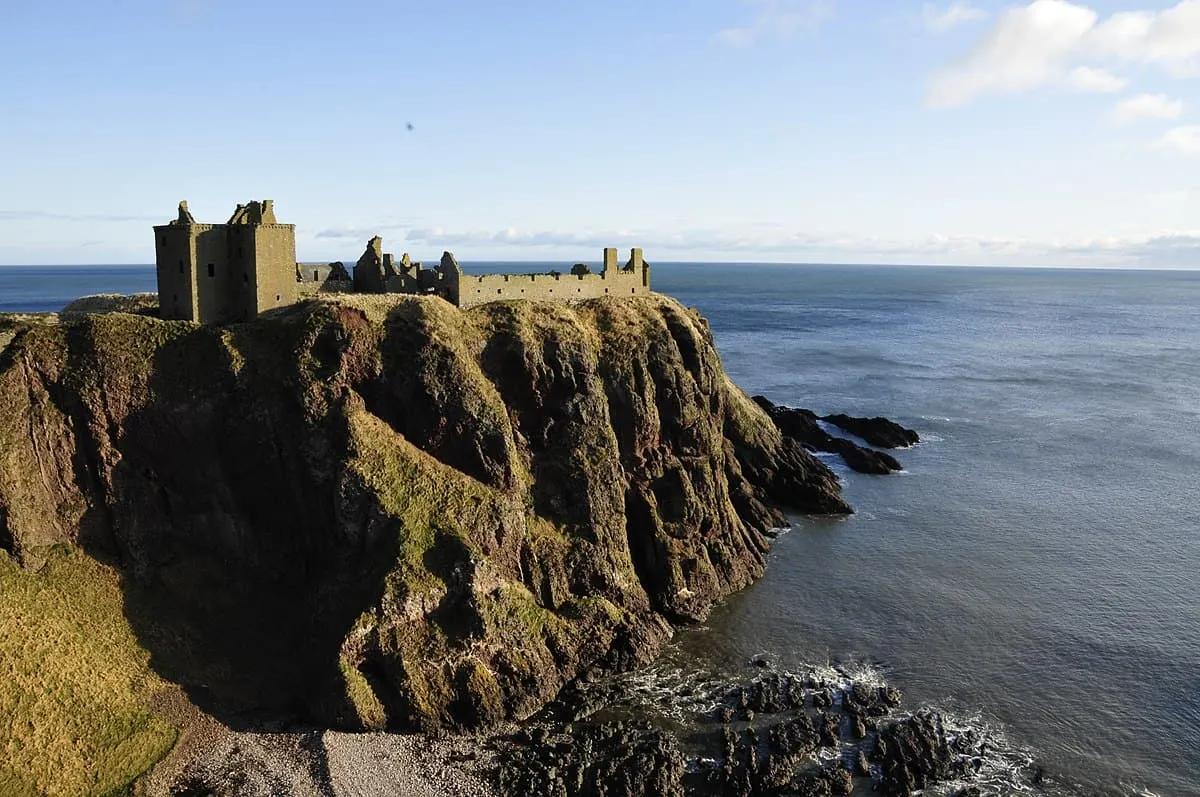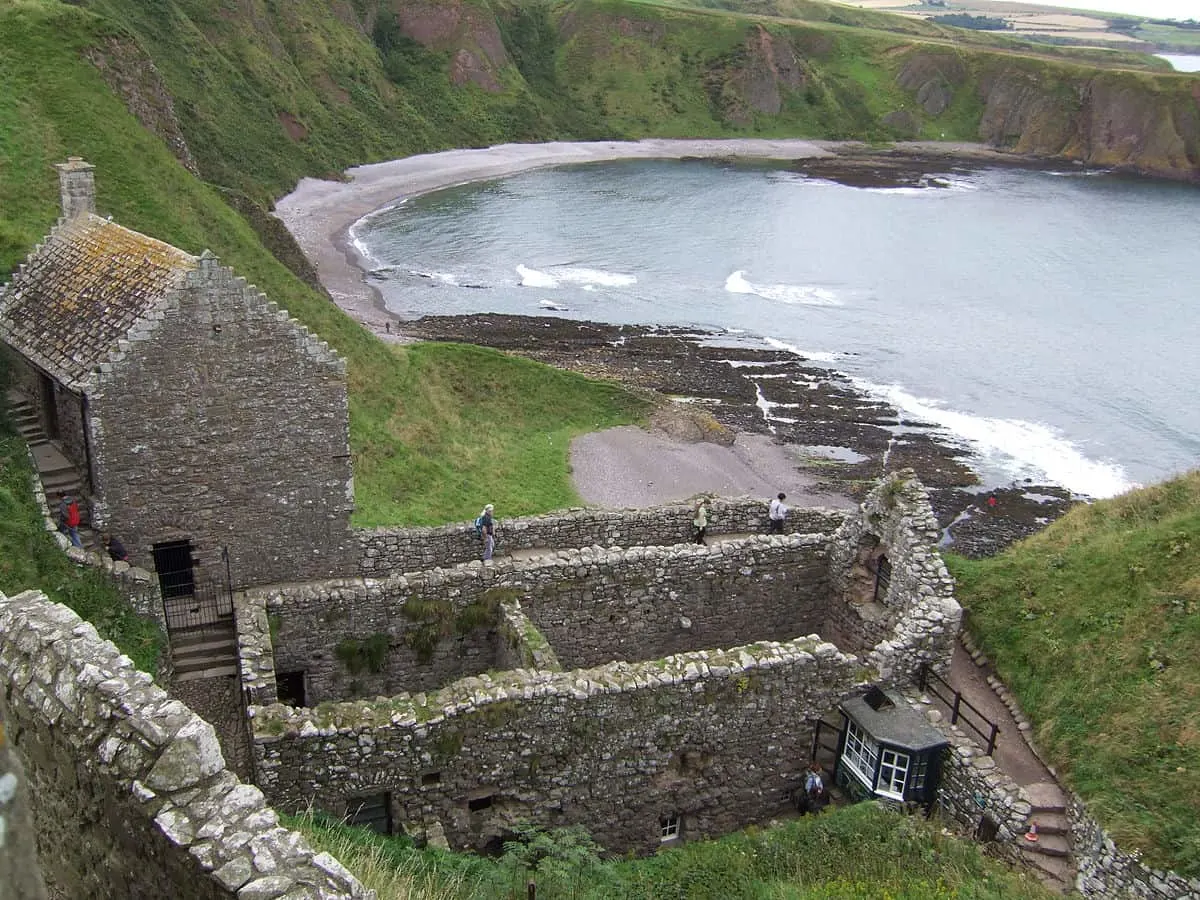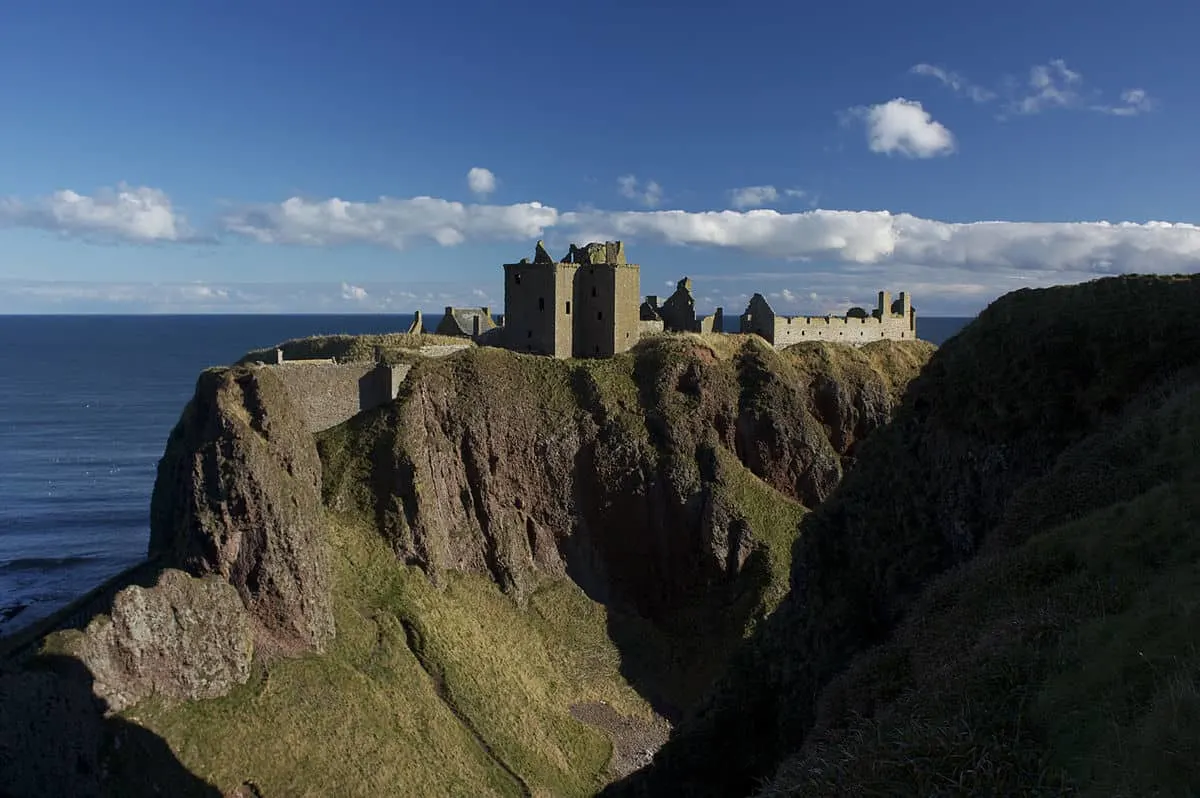One of the most fascinating castles in Europe can be found in a fascinating location in Scotland.
In this post, you’ll discover the ultimate list of facts about Dunnottar Castle!
1. It’s located in the northeast of Scotland
Dunnottar Castle is a mostly ruined medieval fortress located on the northeast coast of Scotland. It’s situated about 2 miles (3 kilometers) south of the town of Stonehaven in the council area of Aberdeenshire.
Stonehaven is located just 15 miles (24 kilometers) south of Aberdeen, the major city in the area and Scotland’s third-most populous city behind Glasgow and Edinburgh.

2. The castle has a very strategic location
The castle has played a major role in the history of Scotland, all the way from the Early Middle Ages until the Jacobite risings in the 18th century.
The reason for this is very simple as it has an extremely strategic location. Control of the castle allowed access to the entire northeast of Scotland as it protects an area of about 2.25 miles (3.6 kilometers) inland.
The castle also has an amazing natural defense in the form of cliffs that drop over 160 feet (50 meters) deep into the North Sea, making it a virtually impenetrable fortress!

3. There were buildings on the site during the Early Middle Ages
The unique location has been utilized as a line of defense for numerous centuries. The Annals of Ulster mention the “Dún Foither” in 681 and 694, which might be the first building on the site.
The Scottish Chronicle mentions that King Donald II of Scotland, the first man to be called “rí Alban” or “King of Alba,” was killed in the area during a Viking attack in the year 900.

No archaeological evidence has been found so far about these structures, so it’s assumed that the buildings on the location of the castle weren’t fortified during the Early Middle Ages.

4. There are 2 fascinating ways to access the castle
There are two main ways to access the castle:
- Via a very steep footpath that has a length of about 2,600 feet (790 meters). This footpath now has a modern staircase, something that was obviously not the case before modern times.
- Via a footpath that runs all across the top of the cliffs and which starts near the town of Stonehaven. This path is about 2 miles (3 kilometers) long.

5. The buildings of the castle were constructed over several centuries
The castle consists of multiple buildings that were constructed over a period of multiple centuries. Several additions to the castle have been made between the 13th and 17th centuries.
All buildings were constructed on a stretch of land covering an area of 1.4 hectares (3.5 acres).

6. The most prominent structure was built in the late 14th century
When you approach the castle, the most prominent building in sight is the massive keep, also referred to as the “tower house.” This structure was built at the end of the 14th century and originally stood 50 feet (15 meters) tall.
This building consisted of a great hall and a private room for the castle’s constable and the bedrooms were upstairs. next to it stands the storage room and the blacksmith’s working space.

7. The Benholm’s Lodging was cut out of the rocks
One of the most remarkable facts about Dunnottar Castle is that one of the gatehouses, which is now referred to as Benholm’s Lodging, was cut entirely out of the rocks of the cliff.
This 5-story building served as both a prison and an extra line of defense since it has 3 tiers of gun ports facing outward towards the entrance of the castle. The entrance of the castle runs underground and consists of 2 tunnels that end near the tower house.
While records of an inventory have shown that 4 massive canons were present here in 1612, some historians have questioned whether or not the canons were actually used for real defense purposes or where more used as a decorative scare tactic.

8. The rooms in the tower house were replaced by a palace
By the end of the 16th century, the rooms in the tower house were replaced by a series of buildings located in the northeast section of the complex. These buildings consist of 3 wings built around a central courtyard.
Construction of this collection of buildings, which is referred to as the “Palace,” lasted well into the 17th century. The main features of the palace are 7 identical buildings and a 120-foot (37 meters) long gallery.

9. A Roman tablet was on display at the palace
The gallery used to be covered with a beautiful oak ceiling, but this has been lost over the centuries. Within one of the rooms of this gallery, a tablet was on display from the Antonine Wall, a fortification built around 142 A.D. during the reign of Roman Emperor Antoninus Pius, and the northernmost border of the Roman Empire.
This tablet has remarkably survived and is now on display at the Hunterian Museum and Art Gallery in Glasgow.

One of the most fascinating facts about Dunnottan Castle is that it was once the hiding place of the Honours of Scotland. This happened around the time that Charles II was crowned in another famous building in Scotland called Scone Palace. The Honours of Scotland, consisting of a crown, sword, and scepter, were used during this event which happened on January 1, 1651.
Because English General Oliver Cromwell and his army were invading Scotland that year, the Honours couldn’t be returned to Edinburgh Castle where they are usually kept.
Somehow, the Honours were smuggled out of the castle before it was surrendered and eventually brought back to Edinburgh, but how this exactly happened remains unclear until today.

11. The castle changed hands multiple times since the 18th century
After Earl Marischal, who still owned the castle in the early 18th century, saw it seized by the crown because of his participation in the Jacobite rebellion of 1715, the castle was sold to the highest bidder a couple of years later. It was eventually sold multiple times in the following centuries and stripped of its valuables in the process.
- The castle was purchased in 1720 for £41,172 by the York Buildings Company.
- It was sold in July 1873 to Major Alexander Innes of Cowie and Raemoir for £80,000.
- It was purchased by Weetman Pearson, 1st Viscount Cowdray, in 1925, and still owned by his family.
Ever since the castle was purchased in the 20th century, repairs have been made and it has been opened to the public as well, attracting thousands of tourists every year!

12. The castle has been a scheduled monument for over 50 years
Ever since 1970, the castle has been registered as a Scheduled Monument, as well as included in the “Category A” of buildings of national importance.
It’s fair to conclude that Dunnottar Castle is one of the most important structures in Scotland’s history and one of the most amazing as well!

